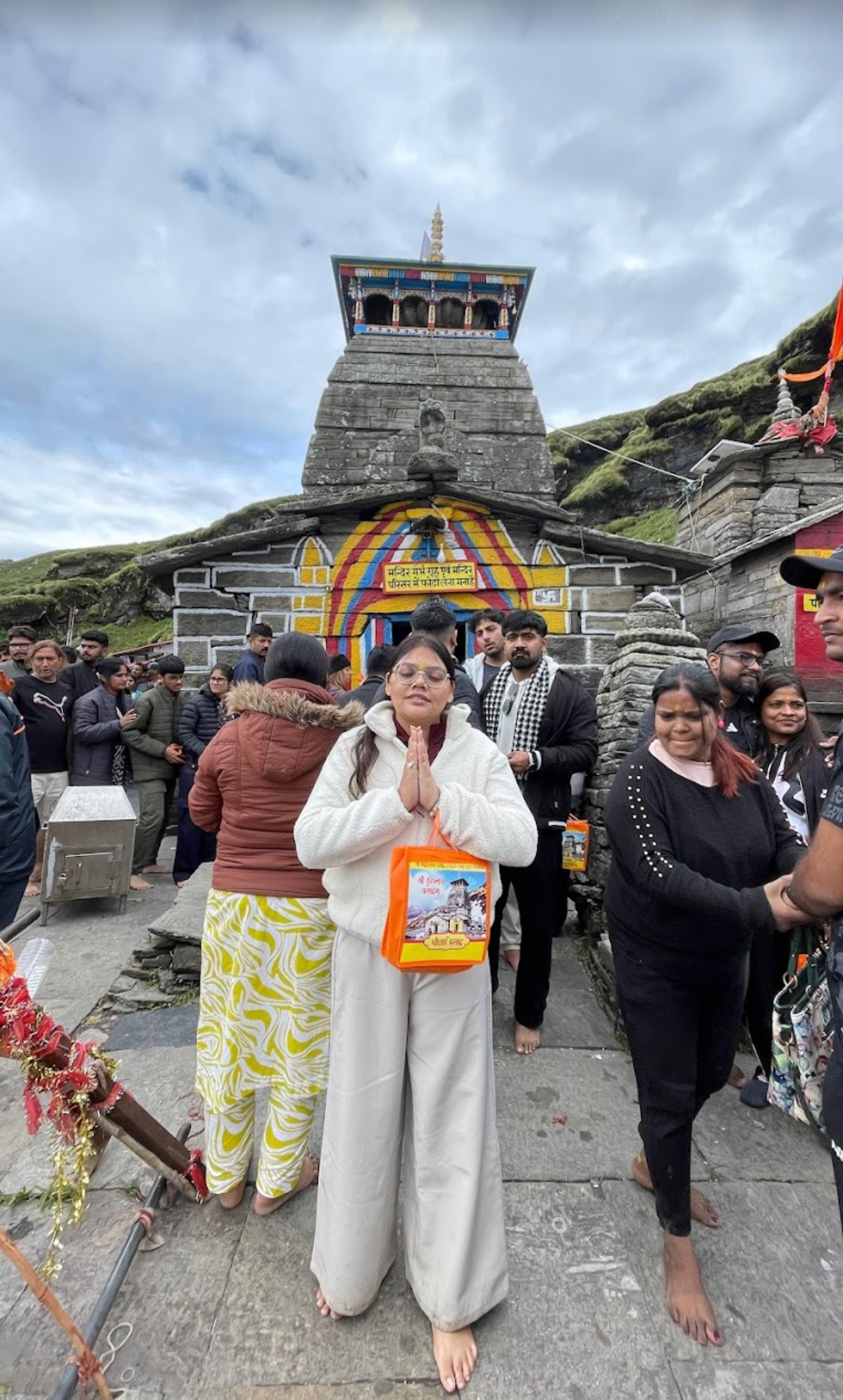Tungnath Temple Trek in monsoonThe sacred month of Sawan holds a special place in the hearts of Hindus, dedicated entirely to the worship of Lord Shiva. It is believed that devout worship during this time can grant wishes and bring blessings. For those seeking a truly profound experience, a visit to Tungnath, the world’s highest Shiva temple, is an incredible option.
Nestled in the breathtaking Chopta Valley at an elevation of 3,680 meters, Tungnath becomes particularly accessible and enchanting during the monsoon season, which coincides with Sawan. While the spiritual significance is a major draw, the journey to this sacred site is just as rewarding.
Tungnath Trek Spiritual and Natural Paradise
Chopta is often called the “Mini Switzerland of Uttarakhand,” and it’s easy to see why. During the monsoon, the landscape undergoes a dramatic transformation. The meadows, known as bugyals, burst into a vibrant sea of green, carpeted with a spectacular array of wildflowers. Walking through these lush fields, with the fresh scent of earth and flowers in the air, feels like stepping into a dream.
The monsoon rains also bring the valley to life with countless streams and waterfalls. As you trek toward Tungnath, you’ll encounter numerous small and large waterfalls cascading down the hillsides, creating a serene and majestic atmosphere. The sound of rushing water, combined with the misty clouds that often blanket the mountains, adds a mystical quality to the entire experience.

Trekking and Tranquility
The trek to Tungnath starts from Chopta and is relatively moderate, making it accessible to most people. The trail winds through dense rhododendron and oak forests, offering panoramic views of the Himalayan peaks. While the path can be a little slippery during the rains, the effort is well worth it. Reaching the temple and offering prayers to Lord Shiva in such a pristine, high-altitude setting is an unforgettable spiritual experience.
Beyond the religious aspect, visiting Chopta in the monsoon is a perfect getaway for nature lovers and photographers. The cloudy skies and misty landscapes provide a dramatic backdrop for stunning photos. You can spend your days exploring the trails, breathing in the crisp mountain air, and simply soaking in the tranquility of the surroundings. It’s a time when you can truly disconnect from the hustle and bustle of city life and reconnect with both nature and your inner self. Whether for faith or for nature, a monsoon trip to Chopta and Tungnath promises an experience that is both spiritually uplifting and visually spectacular.
Experiencing Chopta in the Monsoon: A Guide for Trekkers
If you’re thinking about a trip to Chopta, especially for the famous trek to Tungnath, you might be wondering what it’s like during the monsoon season. This period, from late June to early September, completely changes the landscape. The mountains, which are usually a mix of green and brown, turn into a lush, vibrant paradise.
The air gets cooler and the temperature stays between a comfortable 10°C and 20°C. This makes for a nice, pleasant climate, but it also means things get pretty wet and can be a bit slippery. While this time of year offers a unique and beautiful experience, it also comes with a few things you need to be ready for.
Why You’ll Love a Monsoon Trek to Tungnath
1. A Green, Blooming World: The biggest reason to visit Chopta in the monsoon is the incredible beauty. The rain washes everything clean and makes the forests and meadows come alive. Everywhere you look, you’ll see a deep, vibrant green, and the ground will be covered in all kinds of colorful wildflowers. It’s a photographer’s dream and a treat for anyone who loves nature. Plus, you’ll see dozens of small and large waterfalls flowing down the mountains, adding to the magical scenery.
2. A Peaceful Journey: Unlike the busy summer and autumn seasons, the monsoon sees far fewer tourists. This means you can enjoy a quiet trek, feeling like you have the whole mountain to yourself. The famous Tungnath Temple, which can get crowded, will feel much more peaceful, giving you a chance for a truly spiritual and personal experience.
3. The Enchanting Mist: Imagine walking in a light drizzle with a cool breeze, as a gentle fog rolls through the valley. The clouds often hang low, giving the entire trek a dreamy, otherworldly feel. If you enjoy this kind of misty, serene atmosphere, the monsoon is the perfect time for your trip.
4. Saving Money: Since the monsoon is considered the off-season, you’ll find that hotels and homestays are much cheaper. This is a great chance to find some excellent deals on places to stay and other services, making your trip more budget-friendly.
“Want to know what makes Chopta even more magical during the rainy season? Check out our latest blog on the Top 7 Reasons to Visit Chopta Tungnath Trek in Monsoon 2025 — and discover why this monsoon trek is a must in your travel bucket list.”

What to Be Careful About
1. Slippery Trails: The rain makes the trekking path very muddy and slick. You need to be extra careful with every step, especially on the steeper parts. Make sure you have good quality trekking shoes with a strong grip to avoid any falls or injuries.
2. Road Issues: In the mountains, heavy rain can sometimes cause landslides. This might block the roads that lead to Chopta, which could delay your travel plans or even force you to cancel. It’s always a good idea to check the weather and road conditions before you start your journey.
3. Less Clear Views: While the misty atmosphere is beautiful, it can also hide the stunning views of the Himalayan peaks. If seeing a clear, crisp view of mountains like Nanda Devi or Chaukhamba is your main goal, you might be a little disappointed.
4. Leeches: The wet conditions are perfect for leeches, and you might encounter them on the trail. Don’t worry, though! You can easily protect yourself by wearing long pants and carrying some salt or a special repellent spray to keep them away.
Itinerary For Tungnath Trek In Monsoon
- Departure: Start your journey from Botanical Garden Metro Station at 10:00 PM.
- Overnight Journey: Travel overnight towards Sari Village via Rishikesh.
- Stop at Devprayag: Witness the mesmerizing confluence of the Bhagirathi and Alaknanda rivers along the way.
Day 1: Sari Village to Deoriatal
- Arrival at Sari Village: Check into your homestay and take some time to freshen up.
- Trek to Deoriatal: Begin your trek to Deoriatal (2.5 km, approximately 1.5–2 hours).
- Enjoy Deoriatal: Soak in the serene beauty of the lake and the surrounding landscapes.
- Return to Sari Village: Head back to Sari Village and enjoy a peaceful evening.
Day 2: Sari Village to Tungnath & Chandrashila
- Breakfast: Start your day with a hearty breakfast at your homestay.
- Drive to Chopta: A scenic drive of about 1 hour from Sari Village.
- Trek to Tungnath Temple: Embark on a 3.5 km trek to the sacred Tungnath Temple.
- Summit Chandrashila: Extend your trek by 1.5 km to reach the breathtaking Chandrashila summit.
- Return to Chopta/Sari: After the trek, return to Chopta or Sari for an overnight stay at the campsite.
Day 3: Chopta to Delhi
- Breakfast: Enjoy an early breakfast at your campsite in Chopta.
- Departure: Begin your journey back to Delhi in the early morning.
- Visit Dhari Devi Temple: Stop by the revered Dhari Devi Temple en route.
- Arrival in Delhi: A long drive of approximately 10–12 hours marks the end of your adventure
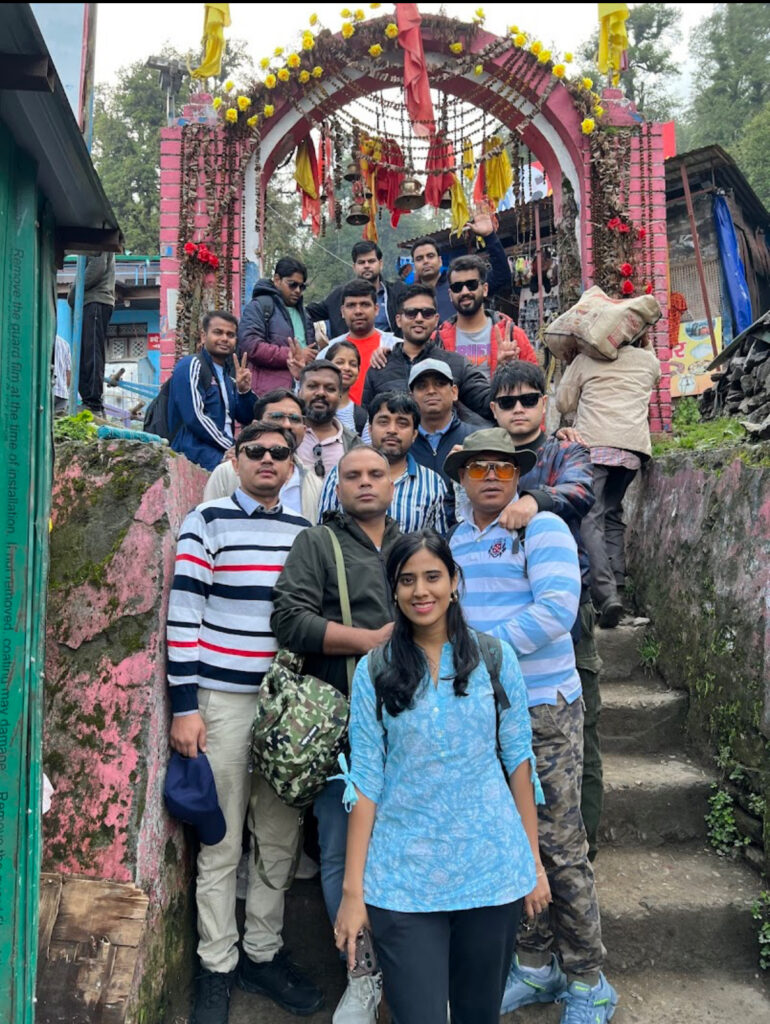
The Spiritual Significance of Sawan
The monsoon season, especially the Hindu month of Sawan, is a very special time for devotees of Lord Shiva. It is believed that during this month, worshipping Lord Shiva can bring great blessings. Tungnath, being the highest Shiva temple in the world, is an ideal place to offer your prayers. The atmosphere here during the monsoon is deeply spiritual. The ancient temple, often surrounded by clouds, feels like a sacred place hidden away from the world. The sound of rain and the cool mountain air create a perfect environment for meditation and prayer.
The Weather and Landscape in Monsoon 2025
The monsoon in Chopta generally starts in late June and lasts until early September. In 2025, you can expect moderate to heavy rainfall during this period. The average temperature stays between a cool 10°C to 20°C, which is comfortable for trekking. However, the constant rain means the paths will be wet and slippery.
The rain transforms the entire region into a vibrant green paradise. The meadows, known as “bugyals,” are full of different species of flowers that bloom in the monsoon. The forests of rhododendron and oak become even more dense and fresh. You’ll see countless small and big waterfalls appearing on the hillsides, adding to the breathtaking scenery. The misty clouds often float low, giving the whole area a dreamy, cinematic feel.
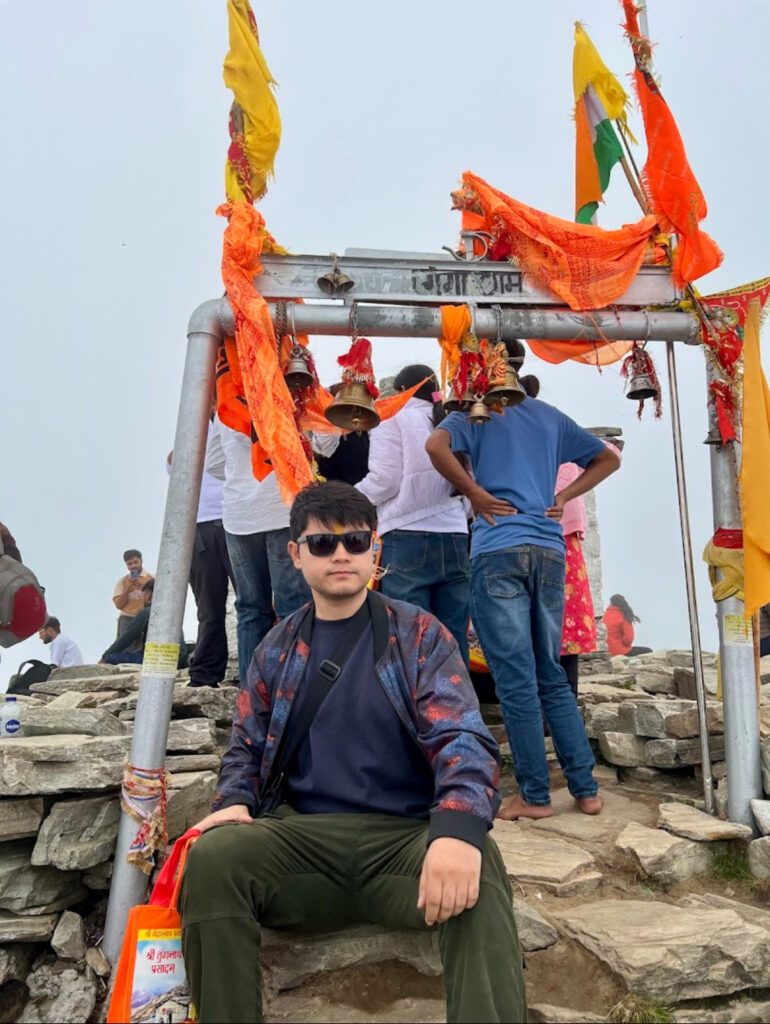
The Tungnath Trek: What to Expect
The trek to Tungnath is considered to be of an easy to moderate difficulty level. The trail is about 3.5 to 4 km long from the Chopta base camp and is a well-defined stone path. While it’s not a very difficult climb, the monsoon makes it more challenging. The stone steps can be very slippery, so it’s very important to wear good trekking shoes with a strong grip.
From Tungnath, you can continue the trek for another 1.5 km to reach the Chandrashila summit. This part of the trek is steeper. During the monsoon, the views from Chandrashila might be blocked by clouds and fog, but reaching the top and standing above the clouds is an experience in itself.
Key Highlights of a Monsoon Trek
1. Unmatched Natural Beauty: The highlight of the monsoon trek is undoubtedly the incredible natural beauty. The entire Chopta Valley becomes a canvas of green, with a rich variety of plants and flowers. It’s a fantastic time for nature lovers and photographers who want to capture the raw, untamed beauty of the Himalayas.
2. Fewer Crowds: Unlike the peak seasons, the monsoon sees fewer tourists. This means you can enjoy the trek and the serene environment without the rush. You’ll have a chance to experience the peace and quiet of the mountains and have a more personal, spiritual time at the Tungnath Temple.
3. Misty and Mystical Vibe: The combination of rain, fog, and clouds gives the trek a mystical feel. Walking through the trails in a light drizzle, with the mist surrounding you, is an unforgettable experience that feels like you’ve stepped into another world.
Important Things to Remember and Plan for
1. Safety First: The biggest challenge in the monsoon is the risk of landslides and road closures. Heavy rain can cause delays, so it’s always wise to check the weather and road conditions before you travel. Having a buffer day in your travel plan is a good idea. Also, be aware of the slippery trails and always use trekking poles for support.
2. What to Pack: Packing the right gear is crucial. You’ll need:
- Waterproof gear: A good quality rain jacket or a poncho and a rain cover for your backpack are a must. Keep all your important belongings like your phone and documents in waterproof pouches.
- Proper Footwear: High-ankle trekking shoes with a strong grip are essential for navigating the muddy and slippery paths.
- Layered Clothing: The temperature can change, so wearing layers is a good idea. Pack quick-dry clothes, a fleece jacket for warmth, and extra socks.
- First-Aid Kit: Carry a basic first-aid kit with medicines for fever, cold, and stomach issues, as well as bandages.
- Leech Repellent: In some areas, leeches can be a concern. Carrying some salt or a special repellent can help.
- Snacks and Water: Pack high-energy snacks like dry fruits and energy bars. Stay hydrated throughout the trek.
3. Accommodation: During the monsoon, many hotels and homestays offer good discounts. While booking, check that the accommodation is safe and well-equipped for the rainy season. Many tour packages from Delhi include accommodation, transportation, and a guide, which can make your trip much easier and safer.
4. Travel Plan: The trek can be completed in one day, but it is often part of a 2-3 day trip that includes visiting other nearby places like the serene Deoriatal Lake. This lake, with its beautiful reflection of the Chaukhamba peaks, is a sight to behold after the monsoon rains have cleared the air.
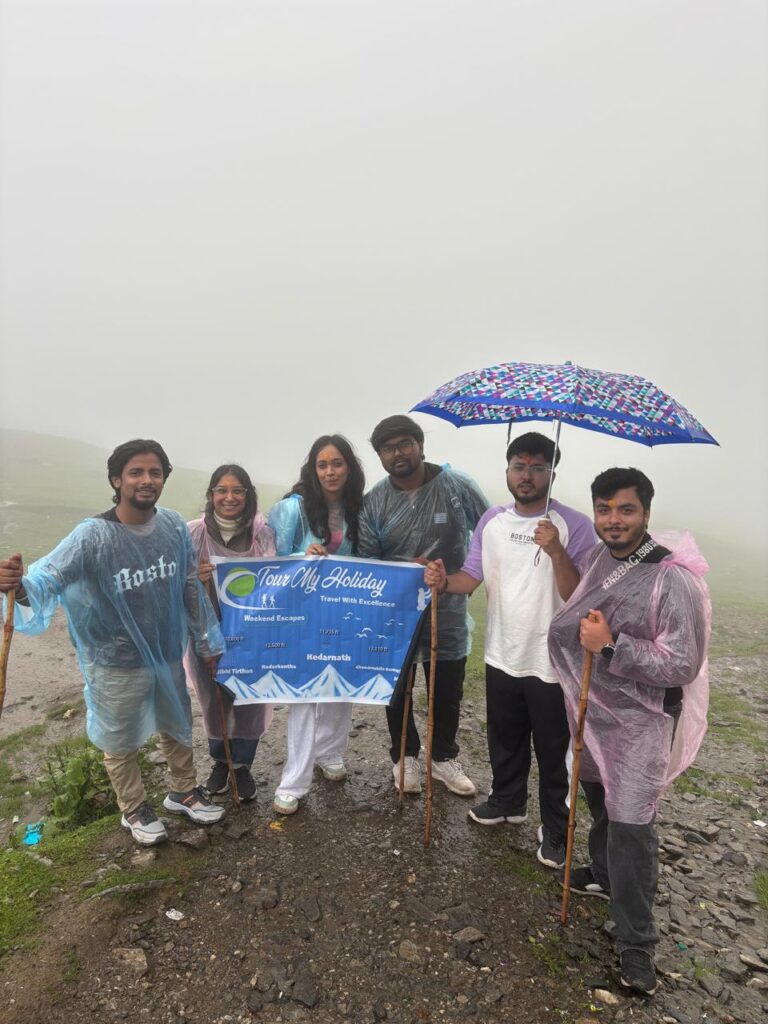
How to Reach Chopta and Tungnath in Monsoon
Getting to Chopta during the monsoon requires a bit more careful planning than in other seasons. The journey itself is an adventure, with the rain making the already beautiful mountain roads even more dramatic.
The Route: Delhi to Chopta
The most common route from Delhi goes through Rishikesh and Rudraprayag. From Rishikesh, you’ll travel along the main highway to Rudraprayag, and from there, you’ll take a smaller road toward Ukhimath and then finally to Chopta. The total distance is about 400 km, and it can take anywhere from 10 to 14 hours, or even longer depending on the road conditions.
Important Monsoon Scenarios to Consider
- Landslides and Roadblocks: This is the biggest thing to watch out for. Heavy rain in the mountains can cause landslides, where mud, rocks, and debris slide onto the road. This can block the road for several hours or even a full day. You might find yourself stuck, so it’s a good idea to keep a day or two as a buffer in your travel plans. Always check the latest weather and road conditions before you start your journey.
- Slippery Roads: The roads, especially the last stretch to Chopta, are narrow and winding. When it rains, they become very slippery. It’s crucial to drive slowly and carefully. If you’re not an experienced mountain driver, it’s safer to hire a local taxi with a driver who knows the roads well.
- Limited Visibility: The constant rain and fog can severely reduce visibility. This makes driving difficult, especially at night. It’s best to start your journey early in the morning and try to reach Chopta before it gets dark.
Getting from Chopta to Tungnath
The trek to Tungnath starts from Chopta. The path is a well-laid stone trail, but in the monsoon, it becomes very muddy and slippery. You cannot take any vehicle from Chopta to Tungnath. You will have to walk. You can, however, hire a pony from the base camp if you don’t feel like trekking.
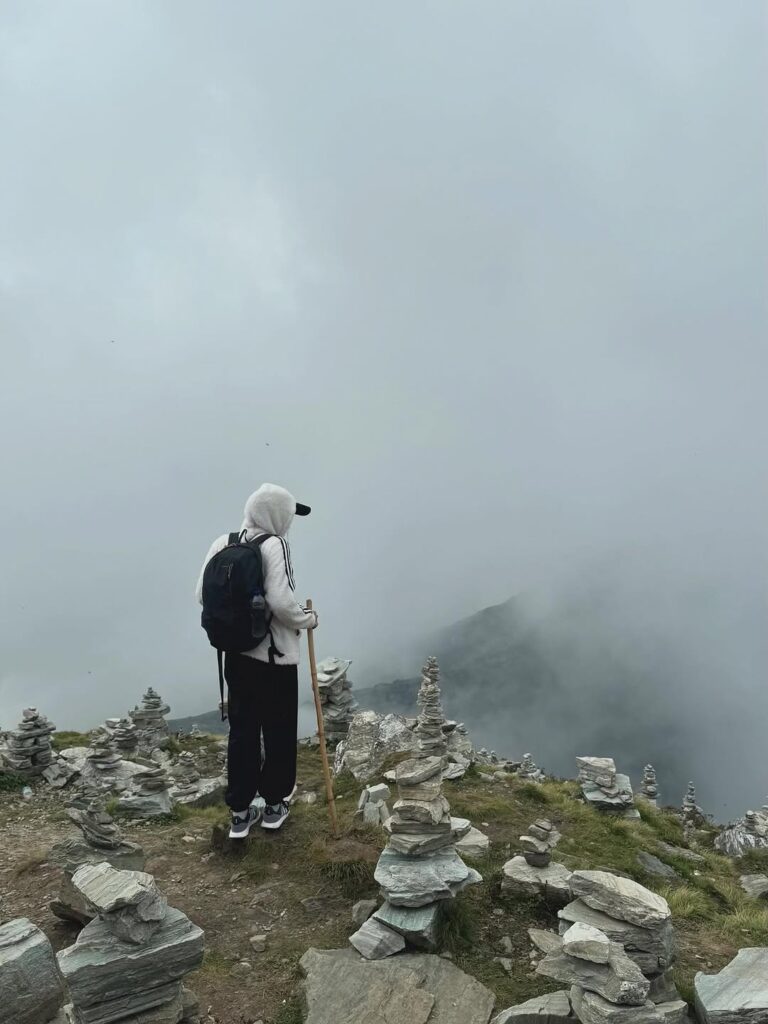
What is special about Tungnath trekking?
- The trail being of easy grade, is suitable to every age group and people, as compared to other Himalayan treks
- As compared to summit treks of Uttarakhand, it is the most easily accessible trek
- It makes you reach, of Tungnath, The highest Shiva Temple in the world
- The trek offers a complete 360-degree view of mighty Himalayan peaks
- Achievement of summiting a Himalayan peak of 4000 metres without much stress.
- You can easily spot some great Himalayan birds during the trail, especially Monal, the National Bird of Nepal on the trails to Tungnath and Chandrashilla. If you are lucky Himalayan Tahr can also be spotted at times
- This is few of the Himalayan Treks which is accessible throughout the year. Though from Dec to Feb the trek comes under moderate category due to heavy snow fall in the region
Why You Should Trek to Deoriatal in Monsoon
The monsoon showers transform the landscape around Deoriatal into a lush, vibrant green paradise. The trek starts from a small, beautiful village called Sari. The path, which is about 3 km long, winds through dense rhododendron and oak forests. During the monsoon, the air is clean and fresh, and the leaves of the trees glisten with rainwater. The ground becomes a rich carpet of green, and the occasional stream or small waterfall adds to the beautiful scenery.
The main attraction is, of course, Deoriatal Lake. In the monsoon, the water levels rise, and on a clear day, the lake perfectly reflects the towering peaks of the Chaukhamba mountain range. Even when the clouds hang low and hide the mountains, the misty atmosphere around the lake is simply breathtaking. It feels like you’re standing in a magical, secret place.
Since this is the off-season, you’ll find the trails and the lake area to be much less crowded. This means you can enjoy the peace and quiet, listen to the sounds of nature, and truly relax without the noise of a lot of tourists. It’s a perfect time for anyone who wants to escape the busy city life and find some calm.
Things to Be Aware of
While the monsoon beauty is amazing, it’s important to be prepared for the challenges. The trekking path can become muddy and slippery, so you need to have good trekking shoes with a strong grip. A rain jacket or a poncho is a must-have to stay dry from the sudden rain showers. Also, be aware of leeches on the trail; they are common in wet forest areas. Wearing long pants and using some salt or repellent can help.
The weather can change quickly in the mountains, so it’s always a good idea to check the forecast. Sometimes, heavy rain can make the drive to Sari village difficult due to the risk of landslides. It’s best to travel with a local taxi driver who knows the area well and is used to these conditions.

Plan Your Adventure: Tungnath Trek Packages
Booking a Tungnath trek package is one of the easiest ways to plan your trip, especially if you’re not an experienced trekker. These packages take care of all the tricky details, so you can focus on enjoying the beautiful scenery and the spiritual journey. Most packages are designed to give you a complete experience, often including the trek to Chandrashila summit and the serene Deoriatal lake.
What a Typical Package Includes
- Transportation: Most packages offer a complete travel solution, often starting from major cities like Delhi, Haridwar, or Rishikesh. This usually includes a comfortable vehicle like a Tempo Traveller or a bus to get you to Chopta, the starting point of the trek.
- Accommodation: You won’t have to worry about where to stay. The packages typically include accommodation in camps or homestays in Chopta, which are a great way to experience the local culture and the mountain environment.
- Meals: From delicious local meals to packed lunches for the trek, all your food needs are usually covered. This makes it a hassle-free trip, as finding good food in the mountains can sometimes be a challenge.
- Expert Guide: A professional and experienced trek leader is a key part of any good package. They not only guide you on the trail but also ensure your safety and share interesting information about the region.
- Other Inclusions: Many packages also cover necessary permits, basic first-aid kits, and even bonfires in the evening for a memorable camping experience.
Why a Package is a Good Idea
For a trek like Tungnath, a package provides a lot of benefits. It’s a great way for beginners to get into trekking safely. You also don’t have to worry about the logistics of travel, stay, and food in a remote area. This allows you to truly immerse yourself in the natural beauty and the spiritual atmosphere of the place.
If you are a solo traveler or a group of friends, a package can be a very cost-effective and social way to explore. You get to meet new people who share a love for the mountains and make new friends along the way.
For a deeper look into what these trips offer, you might want to check out some of the available Tungnath Chandrashila trek packages and see what suits you best. You can find options for different durations and budgets, ensuring you find the perfect trip for your Himalayan adventure.
Why Choose TourMyHoliday for Your Monsoon Tungnath Trek?
Choosing the right travel partner for a monsoon trek is incredibly important, and TourMyHoliday understands the unique challenges and beauty of this season. They specialize in creating packages that make your adventure safe, comfortable, and truly unforgettable.
Here’s why they are a great choice:
1. Safety First, Always: Monsoon in the Himalayas can be unpredictable, with the risk of landslides and slippery trails. TourMyHoliday prioritizes your safety by providing experienced local guides who know the mountains well. Their drivers are skilled in navigating challenging road conditions, and they keep a close eye on the weather to make sure your journey is as smooth as possible. They also provide all-inclusive packages that are well-equipped for monsoon conditions, including waterproof accommodations.
2. A Focus on Experience, Not Just Travel: TourMyHoliday’s packages are designed to give you a complete experience. They don’t just get you from point A to point B; they offer a journey filled with local insights and personal touches. From bonfire nights to guided treks, they make sure every moment of your trip is special. They handle all the logistics—from transportation and stays to meals and guides—so you can simply enjoy the serene, rain-soaked beauty of the Chopta Valley.
3. Budget-Friendly Adventures: They believe that a great Himalayan trek shouldn’t have to be expensive. TourMyHoliday offers a range of affordable packages that are perfect for solo travelers, groups, and couples. You can find all-inclusive plans that cover everything you need, ensuring you have a fantastic experience without breaking the bank.
“Explore the hidden beauty of Chopta with well-designed itineraries and budget-friendly packages offered by TourMyHoliday, your reliable travel partner for Himalayan getaways.”
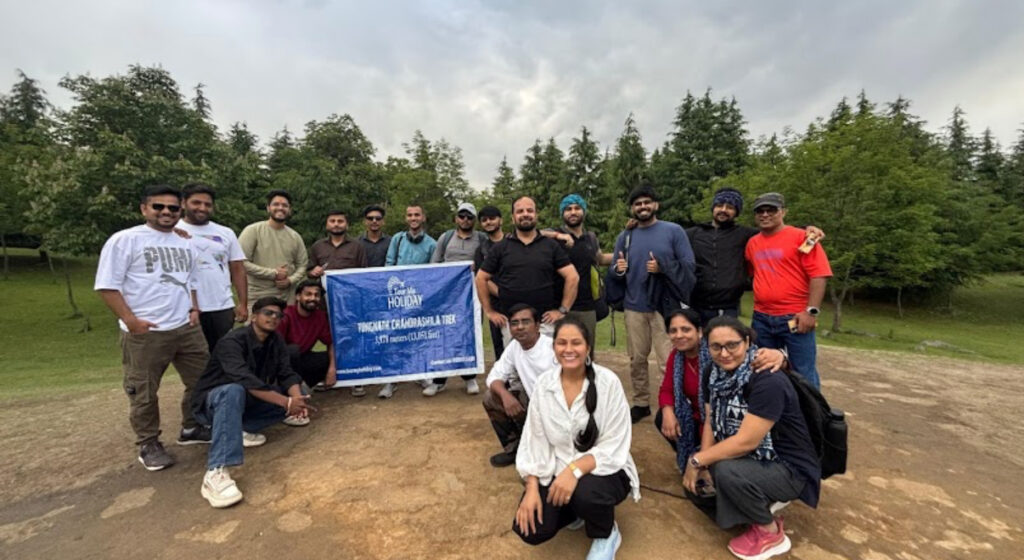
Frequently Asked Questions about the Monsoon Tungnath Trek
What is the best time of day to start the trek? It’s best to start your trek early in the morning. The weather is usually calmer and clearer, and you can finish a significant part of the trek before the afternoon showers begin.
Is it safe to do the Tungnath trek during the monsoon? Yes, but with proper planning and caution. The main risks are slippery trails and potential road closures due to landslides. It’s best to avoid traveling during heavy rain alerts and always check local weather and road conditions.
What are the biggest challenges of a monsoon trek to Tungnath? The biggest challenges are slippery and muddy trails, the risk of landslides blocking roads, and limited views of the Himalayan peaks due to clouds and fog.
How difficult is the Tungnath trek in monsoon? The Tungnath trek is considered easy to moderate. However, the monsoon rain makes the trail more challenging due and slippery. It’s important to be physically prepared and have good trekking shoes.
Will I get to see snow on the Tungnath trek in monsoon? No, the monsoon season is known for its lush green landscapes, not snow. Snowfall in Chopta typically occurs from December to March.
Is the Tungnath Temple open during the monsoon? Yes, the Tungnath Temple remains open during the monsoon. The spiritual significance of the Hindu month of Sawan makes it a popular time for devotees.
What kind of clothes should I pack for a monsoon trek? You should pack waterproof gear like a rain jacket or poncho, and a rain cover for your backpack. Wear quick-drying clothes and bring an extra pair of sturdy, high-ankle trekking shoes with good grip. Layered clothing is also a good idea.
What about leeches? Leeches can be a concern in wet, forested areas during the monsoon. Wearing full-length pants and carrying salt or a leech repellent can help keep them away.
Can I do the trek to Chandrashila summit during the monsoon? Yes, you can, but be prepared for a steeper and potentially more slippery climb. The views from the summit may also be blocked by clouds and fog.
Are there accommodation options available in Chopta during the monsoon? Yes, many hotels and homestays are open and often offer discounts during the off-season. Tour packages often include pre-booked and well-equipped accommodations.
Is there mobile network connectivity in Chopta? Mobile network can be unreliable in Chopta and on the trekking trail. It’s a good idea to let your family know your travel plans in advance and carry a power bank.
How do I deal with landslides and roadblocks? Always check weather and road conditions before you travel. It’s best to have a buffer day in your travel plan in case of unexpected delays. Traveling with an experienced local driver is also highly recommended.
Is the Deoriatal trek also part of the monsoon experience? Yes, many packages combine the Tungnath trek with a visit to Deoriatal. The trek to the lake from Sari village is also transformed by the monsoon greenery, offering a peaceful and beautiful experience.
Do I need a trekking guide for the monsoon trek? While the trail is well-marked, a local guide is highly recommended, especially during the monsoon. They are familiar with the terrain, weather patterns, and safe routes, and can assist in case of any issues.
What is the best way to get to Chopta in the monsoon? The best way is to hire a local taxi or book a tour package that includes transportation with an experienced driver who knows the mountain roads. Driving yourself requires extreme caution due to slippery and unpredictable road conditions.

